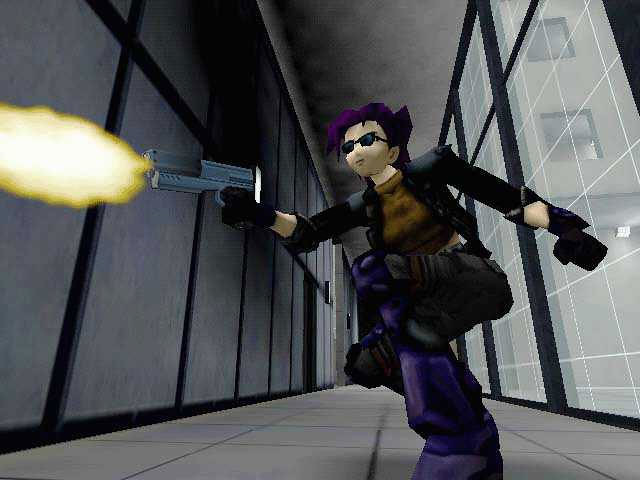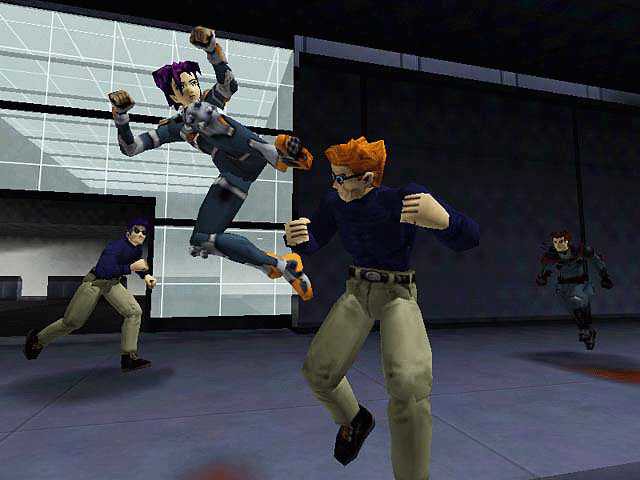It’s easy to forget that Bungie ever made games that were not Halo. Working on the same series for over a decade will do that to you, but first-person shooters were not always the core of Bungie’s creative output. Now that they’re starting anew with Activision, it’s a good opportunity to take a look back at some of their previous work.
Though the company first hit it big with the
Oni, which was also released on PC and Mac, was developed by Bungie West, a spin-off studio that did not last long after Oni’s release. Two of the leads for Oni were Michael Evans and Hamilton Chu, who would work on Halo: Combat Evolved respectively as the multiplayer lead and lead producer. In fact, you can find a surprising amount of Halo’s DNA in Oni.
The story for Oni should be familiar to most Halo players – you play as a soldier, trained from a young age by the government to be a top of the line killing machine, and you’re partnered with a robot girl who chatters in your ear and tells you where to go next. Maybe these similarities are the reason why one of the main power groups in the Halo-verse is the Office of Naval Intelligence – O.N.I. Instead of being an intergalactic space opera, however, Oni’s plot draws inspiration from science-fiction anime such as Ghost in the Shell, and instead of a dour green space marine, Oni has you playing as purple-haired lady cop Konoko.

Though Oni focuses much more on punches, kicks and combo attacks than gunplay, you can still see the evolution of Halo’s combat in the game. While Oni contained a wide variety of firearms, most of which were pretty unique and went beyond the typical “pistol, shotgun, assault rifle” progression of many games, it only allowed the player to carry one gun with them at a time so as to encourage a combination of melee attacks and weaponry. Just months after Oni’s early 2001 release, Halo would launch on the Xbox with combat which emphasized alternating between gun blasts, grenades and punches to defeat its alien adversaries. As the two games were in development at the same time, it’s interesting to see the different approach both took to a similar formula.
Unfortunately, Oni has not aged gracefully in the intervening years. Though it has a solid combo system which encourages players to mix up high attacks, low attacks, throws and blocking, its collision detection is inconsistent, resulting in too many missed hits, and its level design is downright abysmal. The majority of the game is spent either punching samey-looking enemies or scavenging through samey-looking levels for computer terminals to open locked doors. The glib comparison is that Halo: Combat Evolved and Oni are similar in that they both have you running through identical corridors doing the same thing over and over.

This formula worked in Halo, though, because the enemy A.I. was clever enough to provide for different encounters every time you met them, and the presence of vehicles offered a nice change of pace from the on-foot shooting. Oni is a game with almost the same formula as Halo but is hamstrung by technical inadequacies. While Oni does offer a wide variety of combo attacks, it can’t get around the fact that most of its enemies are not a lot of fun to fight.
Though Oni is a footnote in the history of Halo and Bungie, it is still an interesting footnote. If nothing else, it was a stepping stone in the “30 seconds of fun” concept spearheaded by the Halo series.
Still, I can’t help but think that Bungie could do something special with Oni’s combat, especially now that they have some more creative freedom. For all of its flaws, the game’s combat system was fairly solid, and it would be entirely possible for Bungie to shave off the rough edges and make a good next-gen brawler. Combine the acrobatic move set of Konoko in a game with Halo: Reach’s level design and polish and I think we just might have a winner.